Full text
PDF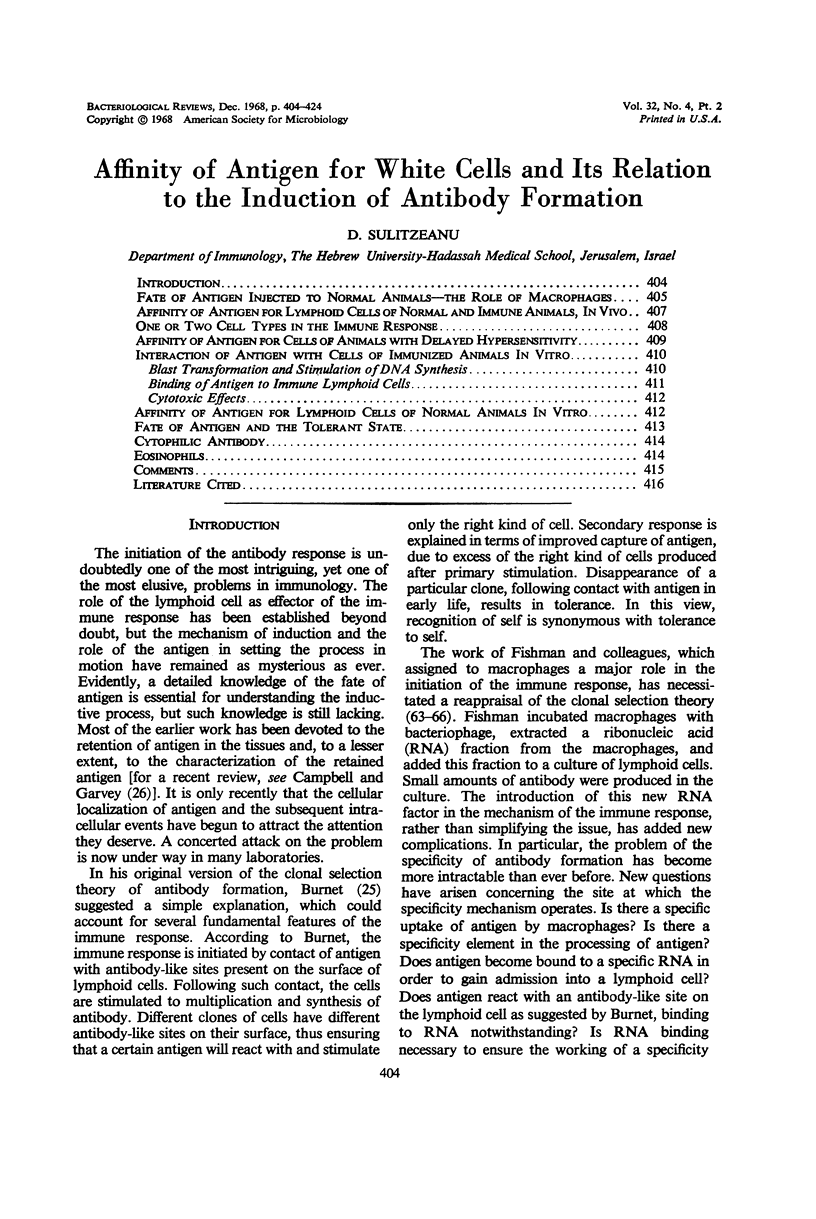


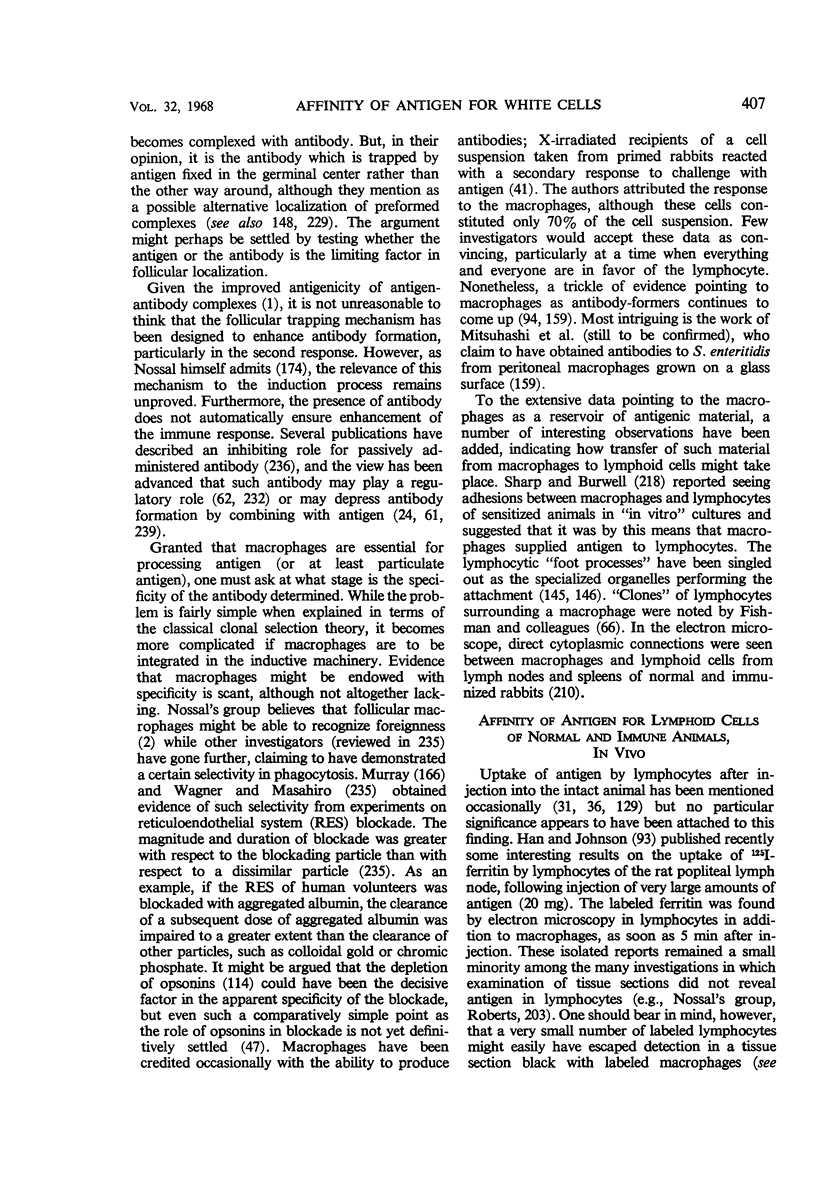
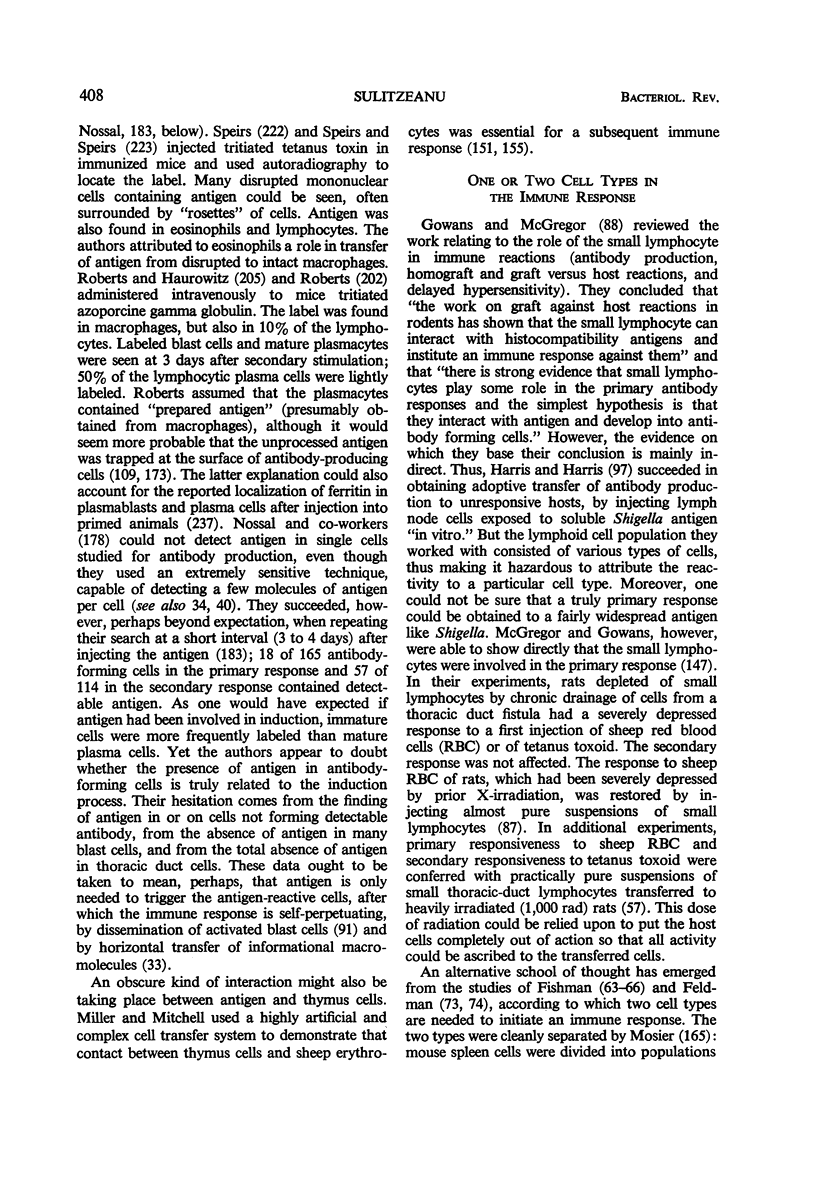
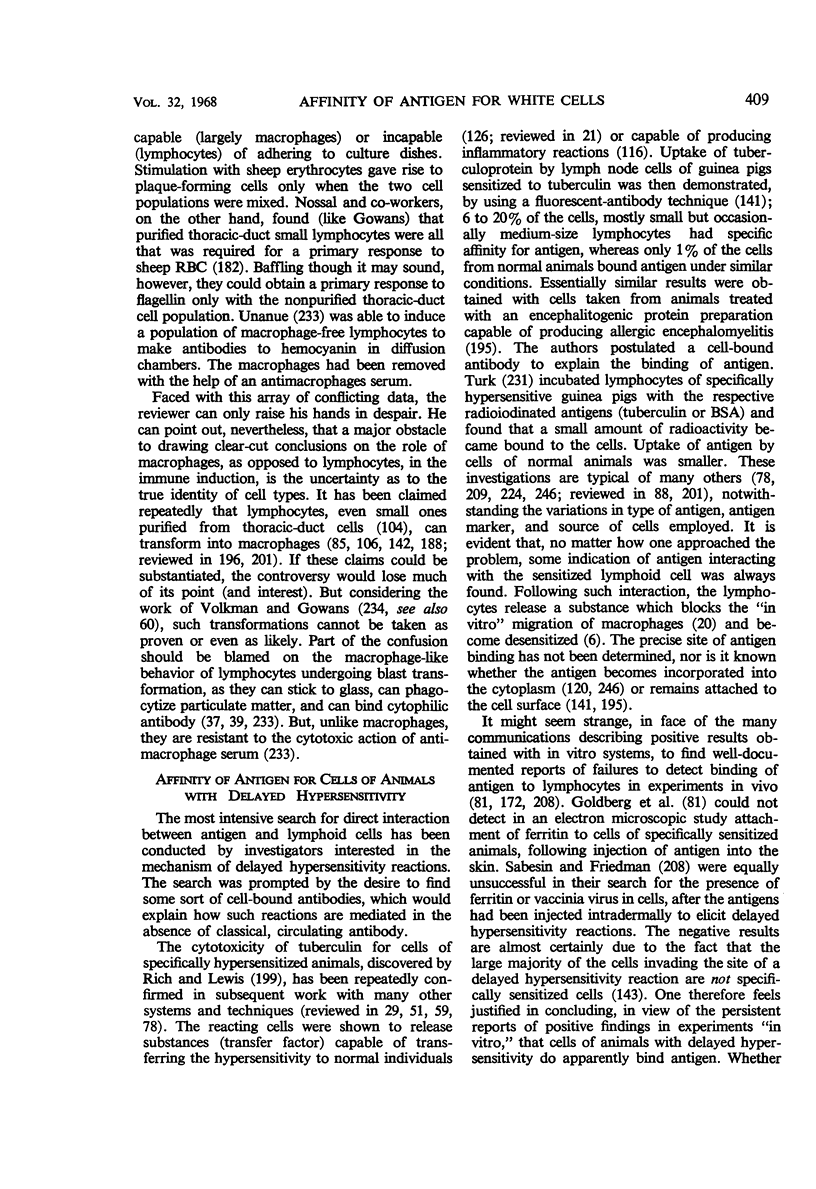
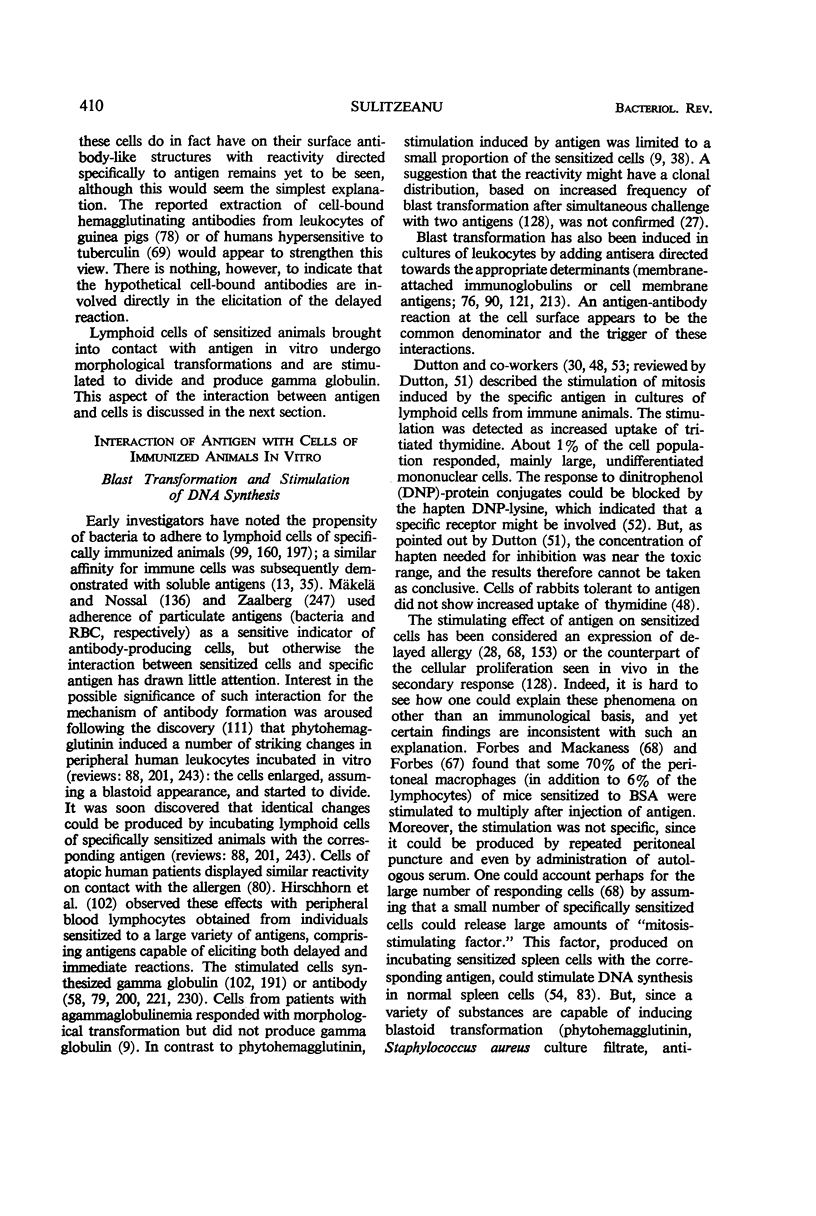
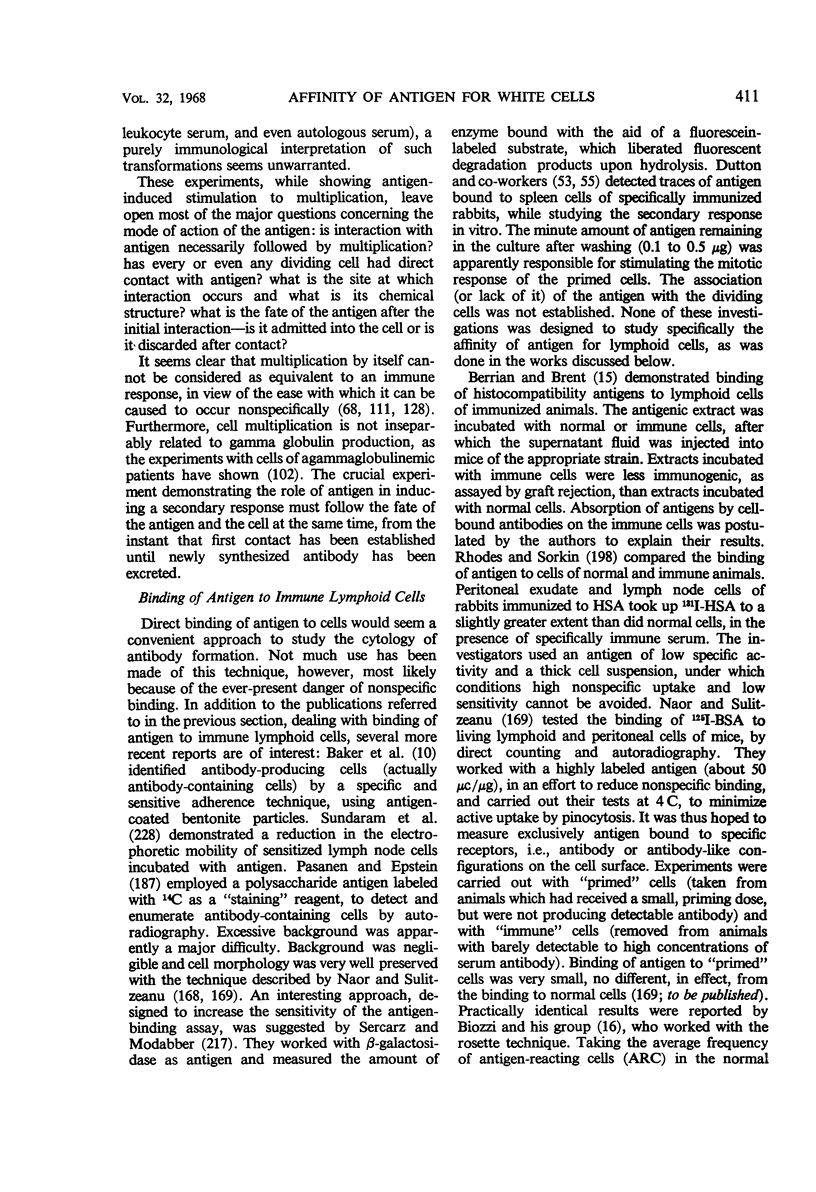
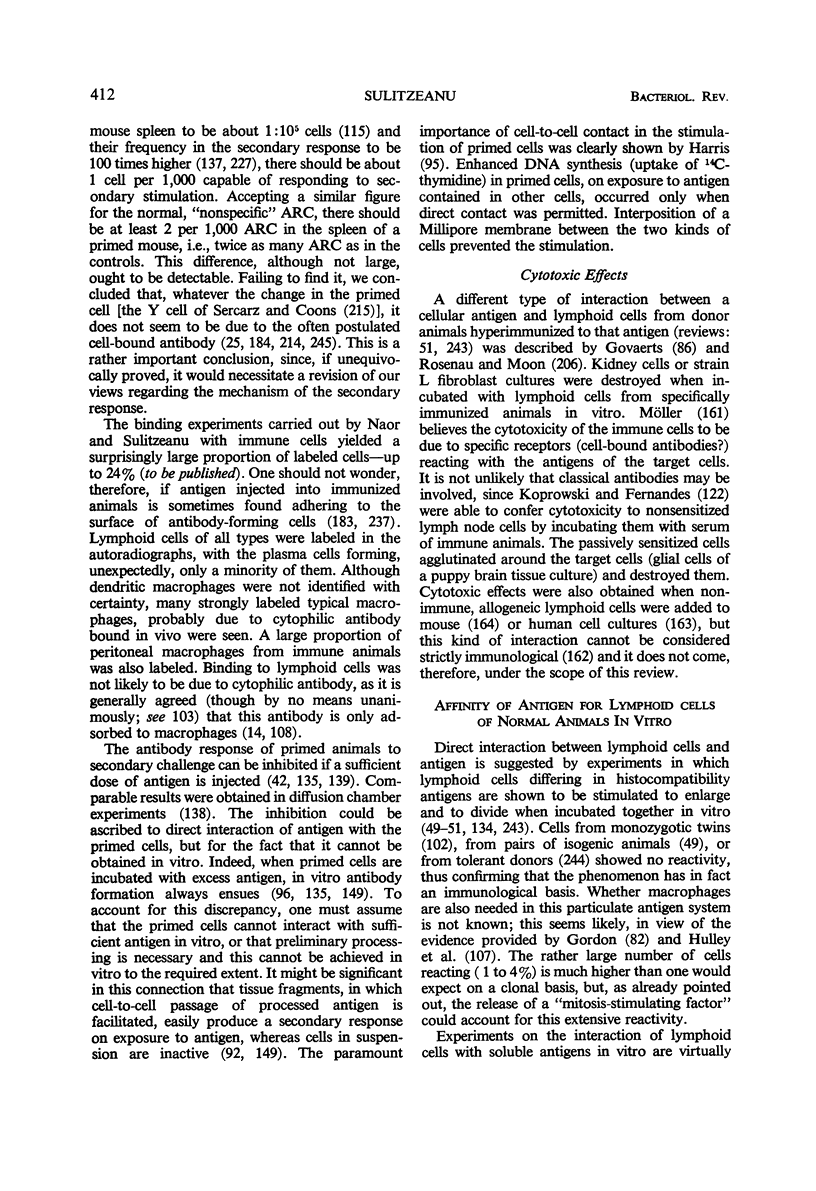


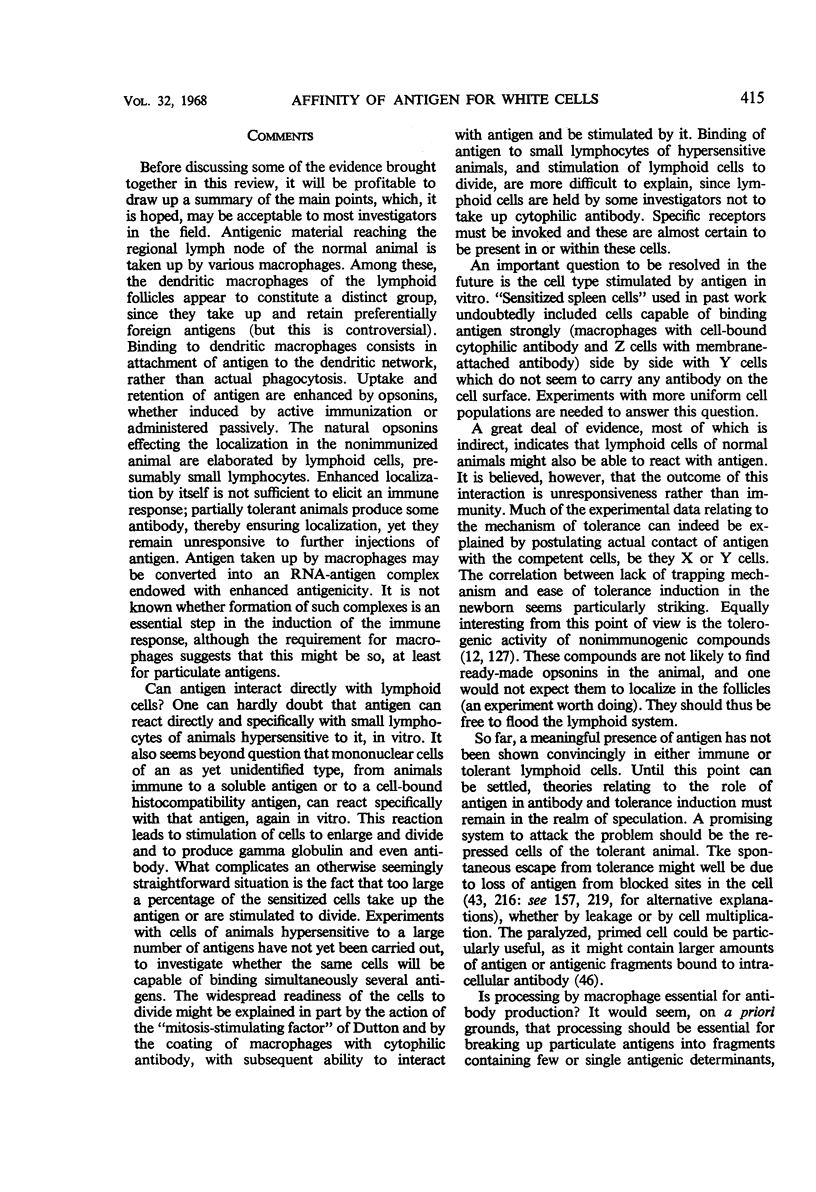
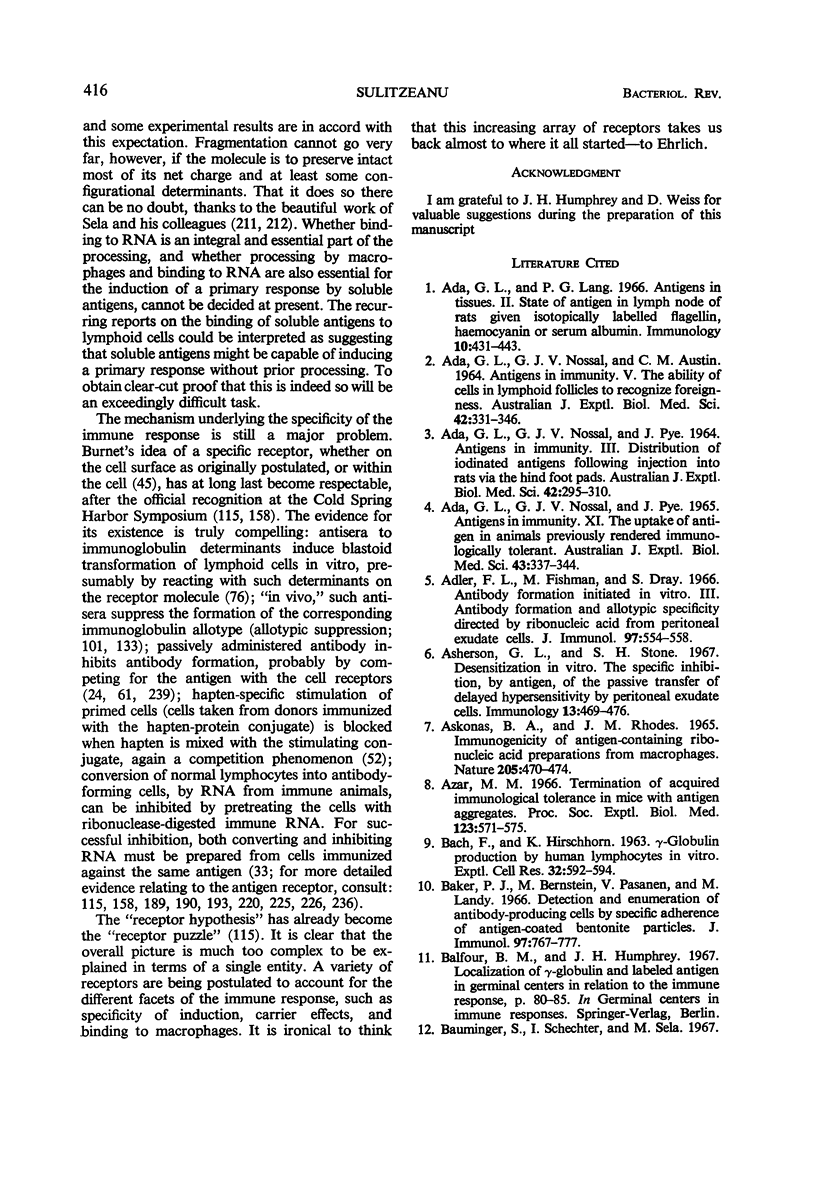
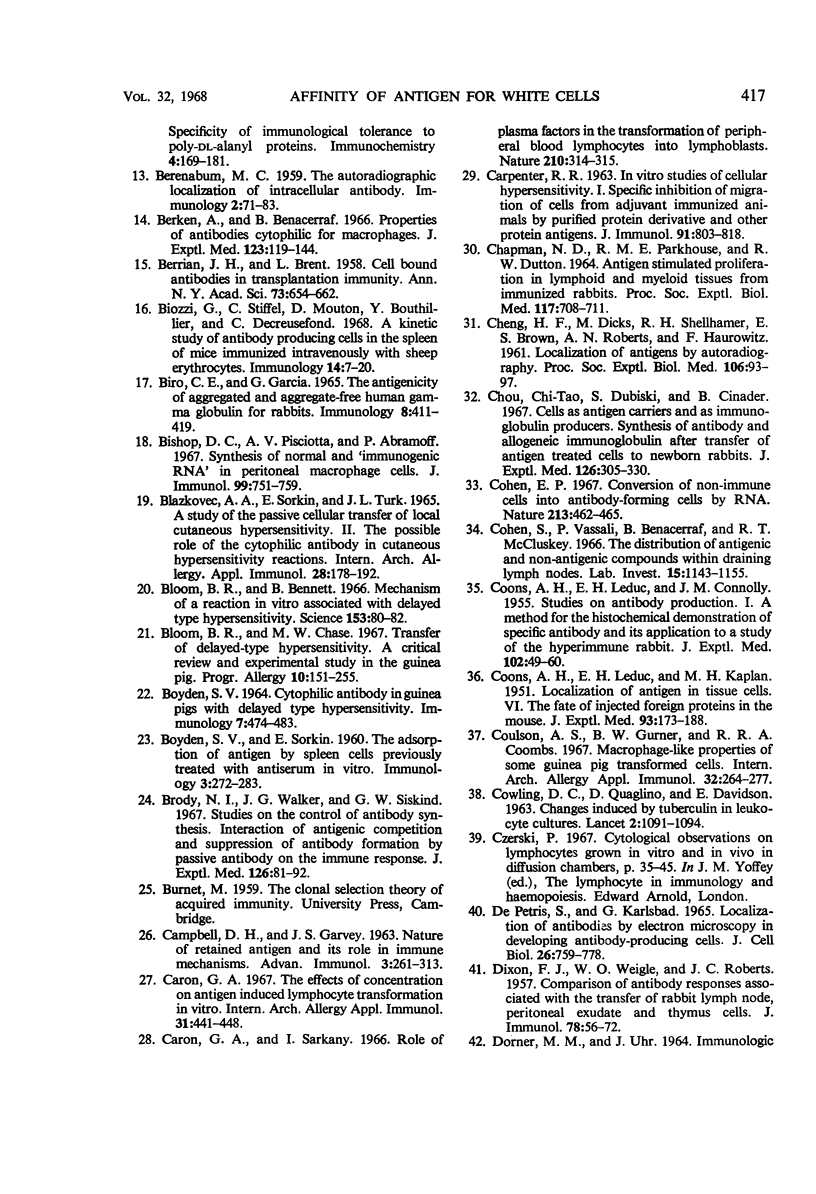

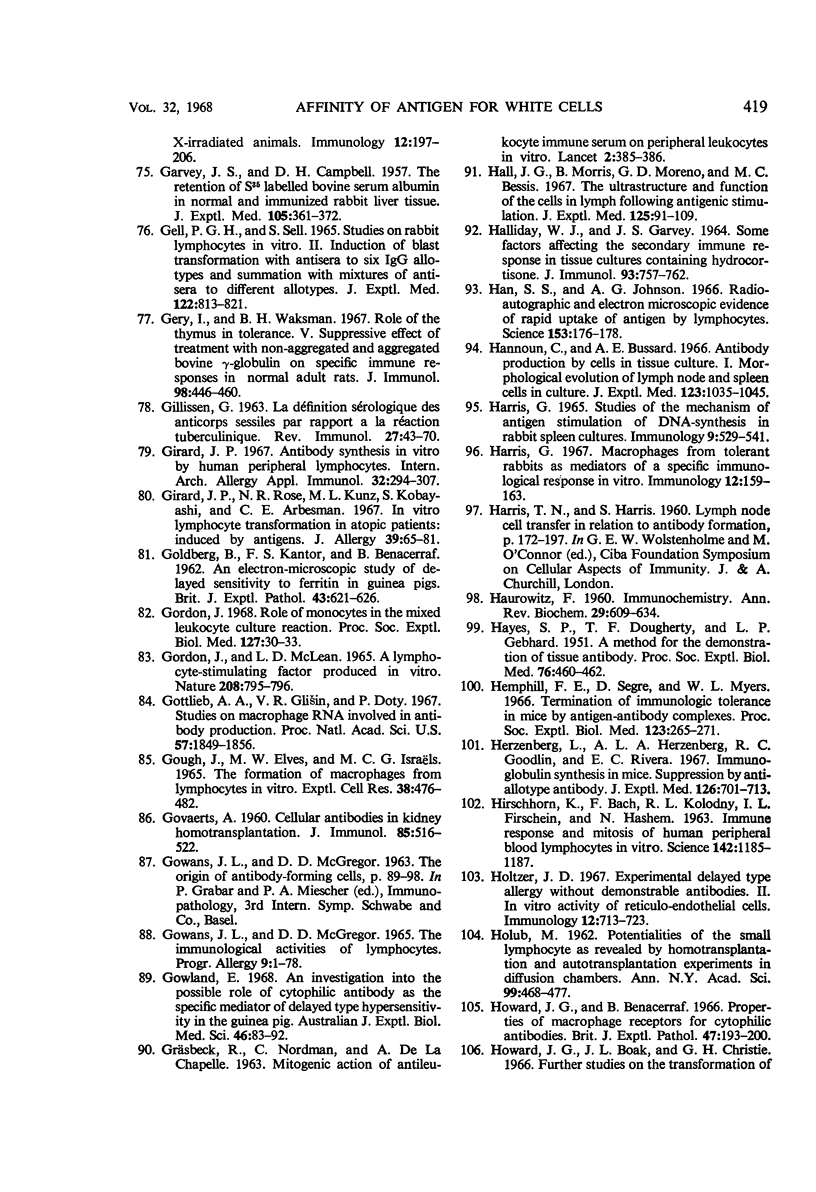

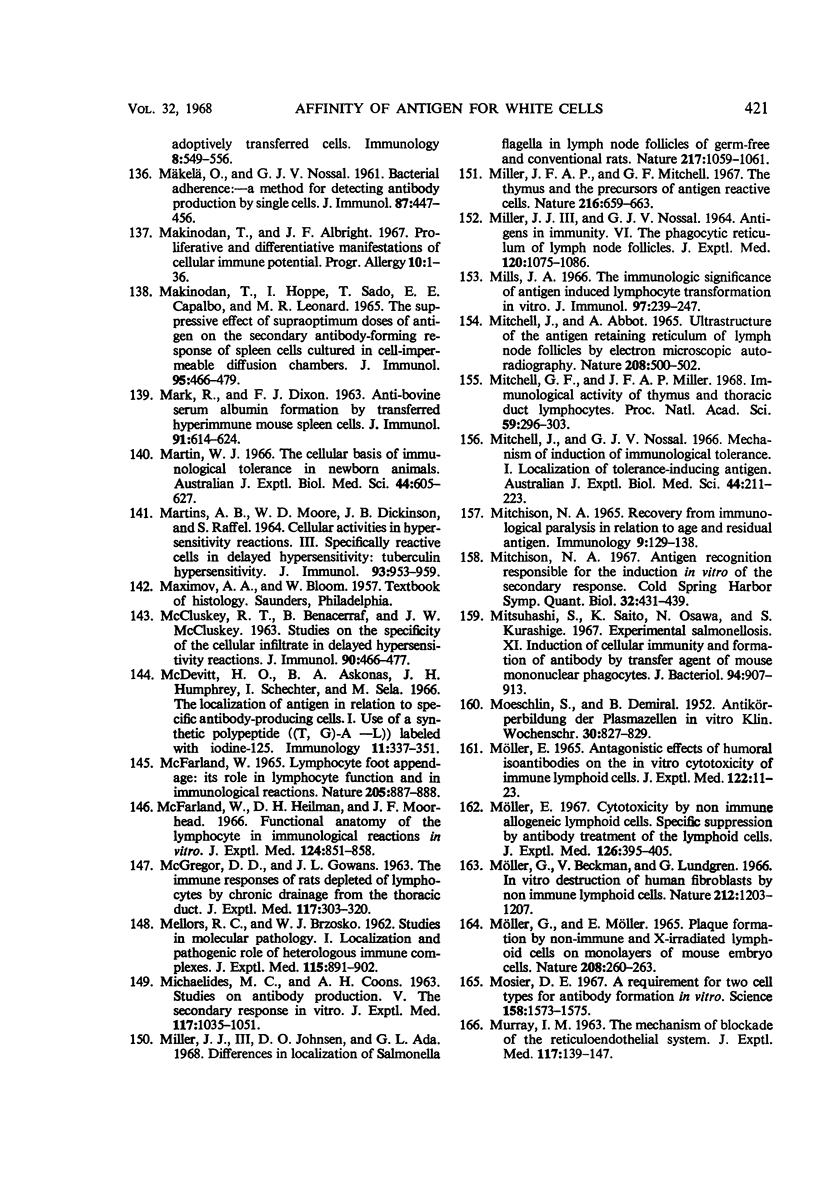
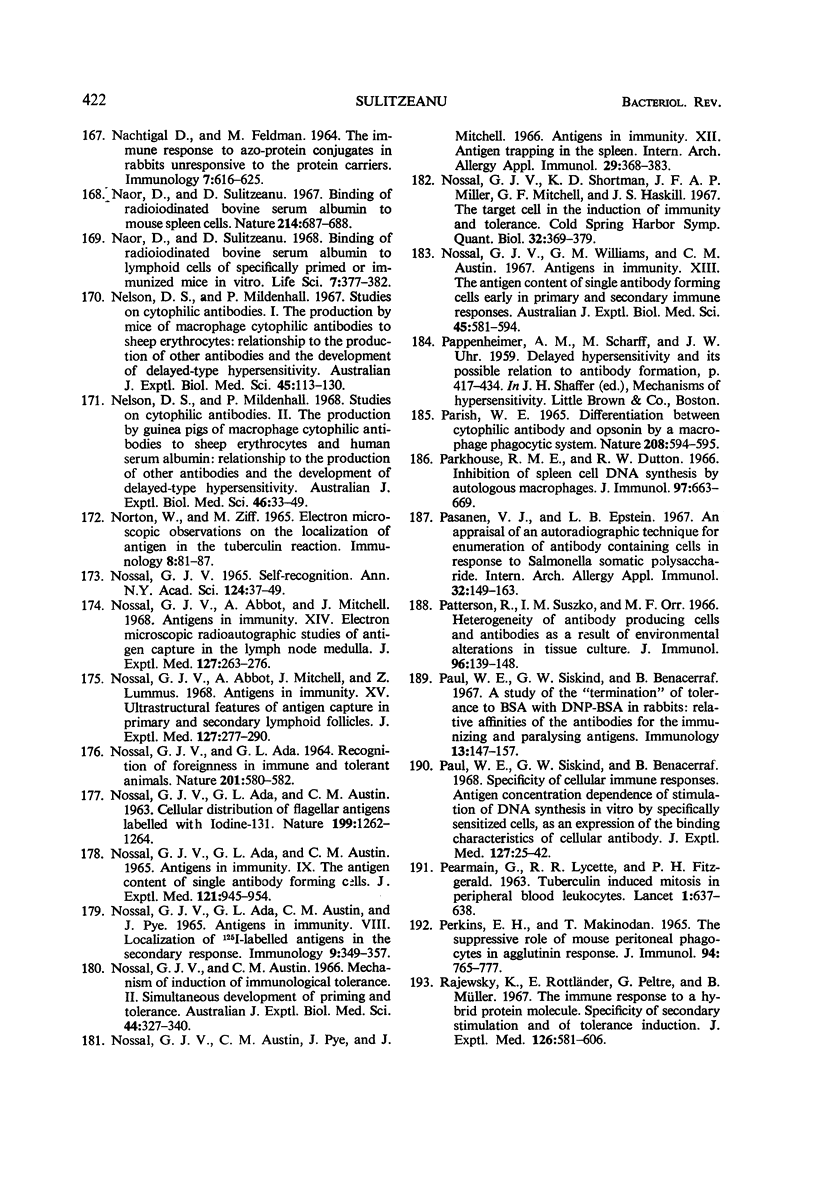

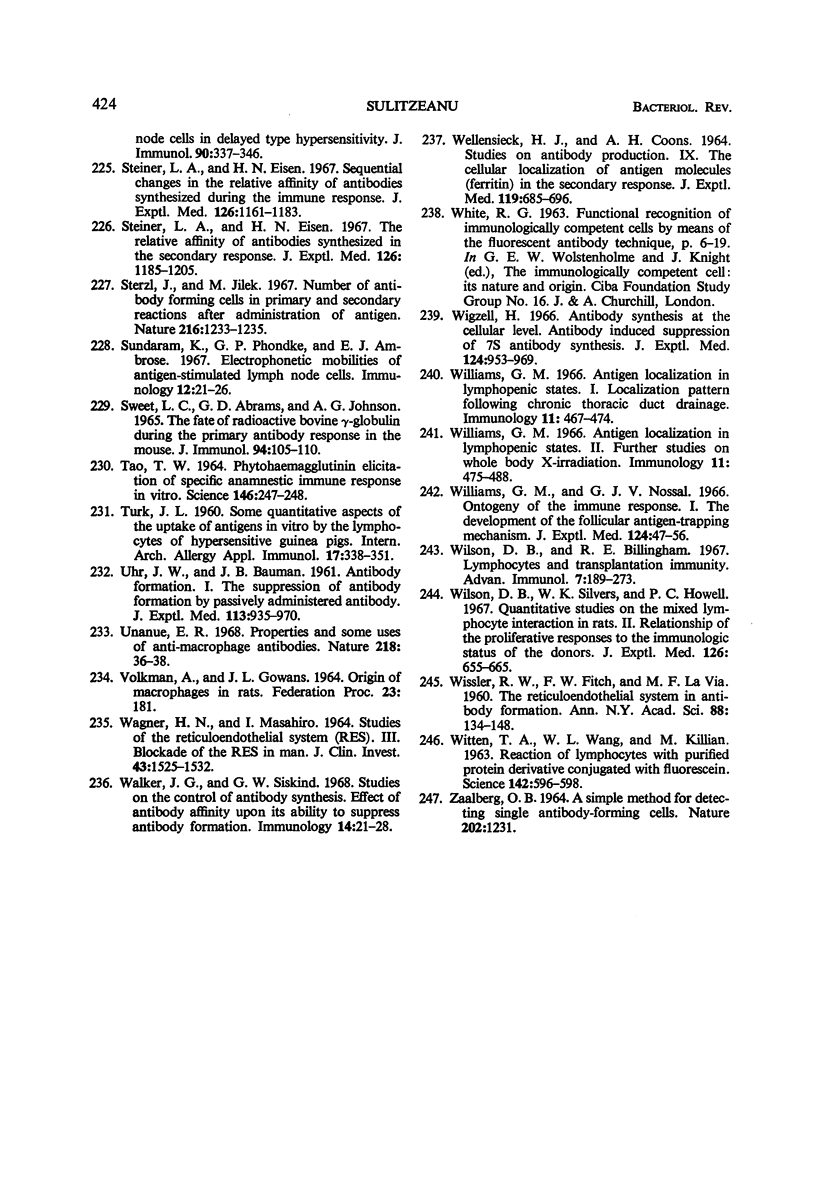
Selected References
These references are in PubMed. This may not be the complete list of references from this article.
- ADA G. L., NOSSAL G. J., AUSTIN C. M. ANTIGENS IN IMMUNITY. V. THE ABILITY OF CELLS IN LYMPHOID FOLLICLES TO RECOGNIZE FOREIGNNESS. Aust J Exp Biol Med Sci. 1964 Jun;42:331–346. [PubMed] [Google Scholar]
- ADA G. L., NOSSAL G. J., PYE J. ANTIGENS IN IMMUNITY. III. DISTRIBUTION OF IODINATED ANTIGENS FOLLOWING INJECTION INTO RATS VIA THE HIND FOOTPADS. Aust J Exp Biol Med Sci. 1964 Jun;42:295–310. [PubMed] [Google Scholar]
- ADA G. L., NOSSAL G. J., PYE J. ANTIGENS IN IMMUNITY. XI. THE UPTAKE OF ANTIGEN IN ANIMALS PREVIOUSLY RENDERED IMMUNOLOGICALLY TOLERANT. Aust J Exp Biol Med Sci. 1965 Jul;43:337–344. [PubMed] [Google Scholar]
- ASKONAS B. A., RHODES J. M. IMMUNOGENICITY OF ANTIGEN-CONTAINING RIBONUCLEIC ACID PREPARATIONS FROM MACROPHAGES. Nature. 1965 Jan 30;205:470–474. doi: 10.1038/205470a0. [DOI] [PubMed] [Google Scholar]
- Adler F. L., Fishman M., Dray S. Antibody formation initiated in vitro. 3. Antibody formation and allotypic specificity directed by ribonucleic acid from peritoneal exudate cells. J Immunol. 1966 Oct;97(4):554–558. [PubMed] [Google Scholar]
- Asherson G. L., Stone S. H. Desensitization in vitro--the specific inhibition, by antigen, of the passive transfer of delayed hypersensitivity by peritoneal exudate cells. Immunology. 1967 Nov;13(5):469–475. [PMC free article] [PubMed] [Google Scholar]
- Azar M. M. Termination of acquired immunological tolerance in mice with antigen aagregates. Proc Soc Exp Biol Med. 1966 Nov;123(2):571–575. doi: 10.3181/00379727-123-31545. [DOI] [PubMed] [Google Scholar]
- BACH F., HIRSCHHORN K. GAMMA-GLOBULIN PRODUCTION BY HUMAN LYMPHOCYTES IN VITRO. Exp Cell Res. 1963 Dec;32:592–595. doi: 10.1016/0014-4827(63)90197-6. [DOI] [PubMed] [Google Scholar]
- BERENBAUM M. C. The autoradiographic localization of intracellular antibody. Immunology. 1959 Jan;2(1):71–83. [PMC free article] [PubMed] [Google Scholar]
- BERRIAN J. H., BRENT L. Cell-bound antibodies in transplantation immunity. Ann N Y Acad Sci. 1958 Oct 7;73(3):654–662. doi: 10.1111/j.1749-6632.1959.tb40841.x. [DOI] [PubMed] [Google Scholar]
- BIRO C. E., GARCIA G. THE ANTIGENICITY OF AGGREGATED AND AGGREGATE-FREE HUMAN GAMMA-GLOBULIN FOR RABBITS. Immunology. 1965 Apr;8:411–419. [PMC free article] [PubMed] [Google Scholar]
- BOYDEN S. V. CYTOPHILIC ANTIBODY IN GUINEA-PIGS WITH DELAYED-TYPE HYPERSENSITIVITY. Immunology. 1964 Jul;7:474–483. [PMC free article] [PubMed] [Google Scholar]
- BOYDEN S. V., SORKIN E. The adsorption of antigen by spleen cells previously treated with antiserum in vitro. Immunology. 1960 Jul;3:272–283. [PMC free article] [PubMed] [Google Scholar]
- Baker P. J., Bernstein M., Pasanen V., Landy M. Detection and enumeration of antibody-producing cells by specific adherence of antigen-coated bentonite particles. J Immunol. 1966 Dec;97(6):767–777. [PubMed] [Google Scholar]
- Bauminger S., Schechter I., Sela M. Specificity of immunological tolerance to poly-DL-aalanyl proteins. Immunochemistry. 1967 May;4(3):169–181. doi: 10.1016/0019-2791(67)90126-7. [DOI] [PubMed] [Google Scholar]
- Berken A., Benacerraf B. Properties of antibodies cytophilic for macrophages. J Exp Med. 1966 Jan 1;123(1):119–144. doi: 10.1084/jem.123.1.119. [DOI] [PMC free article] [PubMed] [Google Scholar]
- Biozzi G., Stiffel C., Mouton D., Bouthillier Y., Decreusefond C. A kinetic study of antibody producing cells in the spleen of mice immunized intravenously with sheep erythrocytes. Immunology. 1968 Jan;14(1):7–20. [PMC free article] [PubMed] [Google Scholar]
- Bishop D. C., Pisciotta A. V., Abramoff P. Synthesis of normal and "immunogenic RNA" in peritoneal macrophage cells. J Immunol. 1967 Oct;99(4):751–759. [PubMed] [Google Scholar]
- Blazkovec A. A., Sorkin E., Turk J. L. A study of the passive cellular transfer of local cutaneous hypersensitivity. II. The possible role of cytophilic antibody in cutaneous hypersensitivity reactions. Int Arch Allergy Appl Immunol. 1965;28(4):178–192. doi: 10.1159/000229661. [DOI] [PubMed] [Google Scholar]
- Bloom B. R., Bennett B. Mechanism of a reaction in vitro associated with delayed-type hypersensitivity. Science. 1966 Jul 1;153(3731):80–82. doi: 10.1126/science.153.3731.80. [DOI] [PubMed] [Google Scholar]
- Bloom B. R., Chase M. W. Transfer of delayed-type hypersensitivity. A critical review and experimental study in the guinea pig. Prog Allergy. 1967;10:151–255. [PubMed] [Google Scholar]
- Brody N. I., Walker J. G., Siskind G. W. Studies on the control of antibody synthesis. Interaction of antigenic competition and suppression of antibody formation by passive antibody on the immune response. J Exp Med. 1967 Jul 1;126(1):81–91. doi: 10.1084/jem.126.1.81. [DOI] [PMC free article] [PubMed] [Google Scholar]
- CARPENTER R. R. IN VITRO STUDIES OF CELLULAR HYPERSENSITIVITY. I. SPECIFIC INHIBITION OF MIGRATION OF CELLS FROM ADJUVANT-IMMUNIZED ANIMALS BY PURIFIED PROTEIN DERIVATIVE AND OTHER PROTEIN ANTIGENS. J Immunol. 1963 Dec;91:803–818. [PubMed] [Google Scholar]
- CHAPMAN N. D., PARKHOUSE R. M., DUTTON R. W. ANTIGEN STIMULATED PROLIFERATION IN LYMPHOID AND MYELOID TISSUES FROM IMMUNIZED RABBITS. Proc Soc Exp Biol Med. 1964 Dec;117:708–711. doi: 10.3181/00379727-117-29674. [DOI] [PubMed] [Google Scholar]
- CHENG H. F., DICKS M., SHELLHAMER R. H., BROWN E. S., ROBERTS A. N., HAUROWITZ F. Localization of antigens by autoradiography. Proc Soc Exp Biol Med. 1961 Jan;106:93–97. doi: 10.3181/00379727-106-26248. [DOI] [PubMed] [Google Scholar]
- COONS A. H., LEDUC E. H., CONNOLLY J. M. Studies on antibody production. I. A method for the histochemical demonstration of specific antibody and its application to a study of the hyperimmune rabbit. J Exp Med. 1955 Jul 1;102(1):49–60. doi: 10.1084/jem.102.1.49. [DOI] [PMC free article] [PubMed] [Google Scholar]
- COONS A. H., LEDUC E. H., KAPLAN M. H. Localization of antigen in tissue cells. VI. The fate of injected foreign proteins in the mouse. J Exp Med. 1951 Feb;93(2):173–188. doi: 10.1084/jem.93.2.173. [DOI] [PMC free article] [PubMed] [Google Scholar]
- COWLING D. C., QUAGLINO D., DAVIDSON E. CHANGES INDUCED BY TUBERCULIN IN LEUCOCYTE CULTURES. Lancet. 1963 Nov 23;2(7317):1091–1094. doi: 10.1016/s0140-6736(63)92860-5. [DOI] [PubMed] [Google Scholar]
- Caron G. A., Sarkany I. Role of plasma factors in the transformation of peripheral blood lymphocytes into lymphoblasts. Nature. 1966 Apr 16;210(5033):314–315. doi: 10.1038/210314a0. [DOI] [PubMed] [Google Scholar]
- Chou C. T., Dubiski S., Cinader B. Cells as antigen carriers and as immunoglobulin producers. Synthesis of antibody and allogeneic immunoglobulin after transfer of antigen-treated cells to newborn rabbits. J Exp Med. 1967 Aug 1;126(2):305–330. doi: 10.1084/jem.126.2.305. [DOI] [PMC free article] [PubMed] [Google Scholar]
- Cohen E. P. Conversion of non-immune cells into antibody-forming cells by RNA. Nature. 1967 Feb 4;213(5075):462–465. doi: 10.1038/213462a0. [DOI] [PubMed] [Google Scholar]
- Cohen S., Vassalli P., Benacerraf B., McCluskey R. T. The distribution of antigenic and nonantigenic compounds within draining lymph nodes. Lab Invest. 1966 Jul;15(7):1143–1155. [PubMed] [Google Scholar]
- Coulson A. S., Gurner B. W., Coombs R. R. Macrophage-like properties of some guinea-pig transformed cells. Int Arch Allergy Appl Immunol. 1967;32(3):264–277. doi: 10.1159/000229936. [DOI] [PubMed] [Google Scholar]
- DIXON F. J., WEIGLE W. O., ROBERTS J. C. Comparison of antibody responses associated with the transfer of rabbit lymph-node, peritoneal exudate, and thymus cells. J Immunol. 1957 Jan;78(1):56–62. [PubMed] [Google Scholar]
- DRESSER D. W. SPECIFIC INHIBITION OF ANTIBODY PRODUCTION. III. APPARENT CHANGES IN THE HALF-LIFE OF BOVINE GAMMA GLOBULIN IN PARALYSED MICE. Immunology. 1963 Jul;6:345–355. [PMC free article] [PubMed] [Google Scholar]
- DRESSER D. W. Specific inhibition of antibody production. II. Paralysis induced in adult mice by small quantities of protein antigen. Immunology. 1962 May;5:378–388. [PMC free article] [PubMed] [Google Scholar]
- DUTTON R. W., BULMAN H. N. THE SIGNIFICANCE OF THE PROTEIN CARRIER IN THE STIMULATION OF DNA SYNTHESIS BY HAPTEN-PROTEIN CONJUGATES IN THE SECONDARY RESPONSE. Immunology. 1964 Jan;7:54–64. [PMC free article] [PubMed] [Google Scholar]
- DUTTON R. W., EADY J. D. AN IN VITRO SYSTEM FOR THE STUDY OF THE MECHANISM OF ANTIGENIC STIMULATION IN THE SECONDARY RESPONSE. Immunology. 1964 Jan;7:40–53. [PMC free article] [PubMed] [Google Scholar]
- DUTTON R. W. THE EFFECT OF ANTIGEN ON THE PROLIFERATION OF SPLEEN CELL SUSPENSIONS FROM TOLERANT RABBITS. J Immunol. 1964 Nov;93:814–815. [PubMed] [Google Scholar]
- Dowden S. J., Sercarz E. E. The X-Y-Z scheme of immunocyte maturation. II. The effect of antigen on spontaneous escape from immune paralysis. J Immunol. 1967 Apr;98(4):827–835. [PubMed] [Google Scholar]
- Dresser D. W. Specific inhibition of antibody production. IV. Standardization of the antigen-elimination test; immunological paralysis of mice previously immunized. Immunology. 1965 Sep;9(3):261–273. [PMC free article] [PubMed] [Google Scholar]
- Drutz D. J., Koenig M. G., Rogers D. E. Further observations on the mechanism of reticuloendothelial blockade. J Exp Med. 1967 Dec 1;126(6):1087–1098. doi: 10.1084/jem.126.6.1087. [DOI] [PMC free article] [PubMed] [Google Scholar]
- Dutton R. W. Further studies of the stimulation of DNA synthesis in cultures of spleen cell suspensions by homologous cells in inbred strains of mice and rats. J Exp Med. 1965 Oct 1;122(4):759–770. doi: 10.1084/jem.122.4.759. [DOI] [PMC free article] [PubMed] [Google Scholar]
- Dutton R. W. In vitro studies of immunological responses of lymphoid cells. Adv Immunol. 1967;6:253–336. doi: 10.1016/s0065-2776(08)60524-6. [DOI] [PubMed] [Google Scholar]
- Dutton R. W. Symposium on in vitro studies of the immune response. II. Significance of the reaction of lymphoid cells to homologous tissue. Bacteriol Rev. 1966 Jun;30(2):397–407. doi: 10.1128/br.30.2.397-407.1966. [DOI] [PMC free article] [PubMed] [Google Scholar]
- Easty G. C., Trowell O. A. The uptake of fluorescence-labelled plasma protein by cells in organ culture. Exp Cell Res. 1965 Nov;40(2):224–232. doi: 10.1016/0014-4827(65)90256-9. [DOI] [PubMed] [Google Scholar]
- Eskowitz S. Production of hapten-specific unresponsiveness in adult guinea-pigs by prior injection of monovalent conjugates. Immunology. 1967 Jul;13(1):9–17. [PMC free article] [PubMed] [Google Scholar]
- FAVOUR C. B. Cell injury in allergic inflammation. Int Arch Allergy Appl Immunol. 1957;10(4):193–224. doi: 10.1159/000228377. [DOI] [PubMed] [Google Scholar]
- FINKELSTEIN M. S., UHR J. W. SPECIFIC INHIBITION OF ANTIBODY FORMATION BY PASSIVELY ADMINISTERED 19S AND 7S ANTIBODY. Science. 1964 Oct 2;146(3640):67–69. doi: 10.1126/science.146.3640.67. [DOI] [PubMed] [Google Scholar]
- FISHMAN M., ADLER F. L. Antibody formation initiated in vitro. II. Antibody synthesis in x-irradiated recipients of diffusion chambers containing nucleic acid derived from macrophages incubated with antigen. J Exp Med. 1963 Apr 1;117:595–602. doi: 10.1084/jem.117.4.595. [DOI] [PMC free article] [PubMed] [Google Scholar]
- FISHMAN M. Antibody formation in vitro. J Exp Med. 1961 Dec 1;114:837–856. doi: 10.1084/jem.114.6.837. [DOI] [PMC free article] [PubMed] [Google Scholar]
- FISHMAN M., HAMMERSTROM R. A., BOND V. P. In vitro transfer of macrophage RNA to lymph node cells. Nature. 1963 May 11;198:549–551. doi: 10.1038/198549a0. [DOI] [PubMed] [Google Scholar]
- FORBES I. J., MACKANESS G. B. MITOSIS IN MACROPHAGES. Lancet. 1963 Dec 7;2(7319):1203–1204. doi: 10.1016/s0140-6736(63)92927-1. [DOI] [PubMed] [Google Scholar]
- FREEDMAN S. O., TURCOTTE R., FISH A. J., SEHON A. H. The in vitro detection of "cell-fixed" hemagglutinating antibodies to tuberculin purified protein derivative (PPD) in humans. J Immunol. 1963 Jan;90:52–59. [PubMed] [Google Scholar]
- FREI P. C., BENACERRAF B., THORBECKE G. J. PHAGOCYTOSIS OF THE ANTIGEN, A CRUCIAL STEP IN THE INDUCTION OF THE PRIMARY RESPONSE. Proc Natl Acad Sci U S A. 1965 Jan;53:20–23. doi: 10.1073/pnas.53.1.20. [DOI] [PMC free article] [PubMed] [Google Scholar]
- FRIEDMAN H. PREVENTION OF IMMUNOLOGIC UNRESPONSIVENESS TO SHIGELLA ANTIGENS IN NEONATAL MICE BY HOMOLOGOUS SPLEEN CELL TRANSPLANTS. J Immunol. 1964 Feb;92:201–207. [PubMed] [Google Scholar]
- Fikrig S., Gordon F., Uhr J. W. Culture of leucocytes from rabbit blood and lymph: effect of phytohemagglutinin and growth of macrophages. Proc Soc Exp Biol Med. 1966 Jun;122(2):379–382. doi: 10.3181/00379727-122-31139. [DOI] [PubMed] [Google Scholar]
- Fink C. W., LoSpalluto J. J. The effect of 7S and 19S antibodies on the primary response to Salmonella typhi antigens. Immunology. 1967 Mar;12(3):259–266. [PMC free article] [PubMed] [Google Scholar]
- Forbes I. J. Mitosis in mouse peritoneal macrophages. J Immunol. 1966 Apr;96(4):734–743. [PubMed] [Google Scholar]
- Friedman H. P., Stavitsky A. B., Solomon J. M. Induction in vitro of antibodies to phage T2: antigens in the RNA extract employed. Science. 1965 Sep 3;149(3688):1106–1107. doi: 10.1126/science.149.3688.1106. [DOI] [PubMed] [Google Scholar]
- GARVEY J. S., CAMPBELL D. H. The retention of S35-labelled bovine serum albumin in normal and immunized rabbit liver tissue. J Exp Med. 1957 Apr 1;105(4):361–372. doi: 10.1084/jem.105.4.361. [DOI] [PMC free article] [PubMed] [Google Scholar]
- GILLISSEN G. [Serologic definition of sessile antibodies in relation to the tuberculin reaction]. Rev Immunol Ther Antimicrob. 1963 Jan-Mar;27:43–70. [PubMed] [Google Scholar]
- GOLDBERG B., KANTOR F. S., BENACERRAF B. An electron microscopic study of delayed sensitivity to ferritin in guinea-pigs. Br J Exp Pathol. 1962 Dec;43:621–626. [PMC free article] [PubMed] [Google Scholar]
- GOUGH J., ELVES M. W., ISRAUELS M. C. THE FORMATION OF MACROPHAGES FROM LYMPHOCYTES IN VITRO. Exp Cell Res. 1965 Jun;38:476–482. doi: 10.1016/0014-4827(65)90371-x. [DOI] [PubMed] [Google Scholar]
- GOVAERTS A. Cellular antibodies in kidney homotransplantation. J Immunol. 1960 Nov;85:516–522. [PubMed] [Google Scholar]
- GRASBECK R., NORDMAN C., DELACHAPELLE A. MITOGENIC ACTION OF ANTILEUCOCYTE IMMUNE SERUM ON PERIPHERAL LEUCOCYTES IN VITRO. Lancet. 1963 Aug 24;2(7304):385–386. doi: 10.1016/s0140-6736(63)93062-9. [DOI] [PubMed] [Google Scholar]
- Gallily R., Feldman M. The induction of antibody production in x-irradiated animals by macrophages that interacted with antigen. Isr J Med Sci. 1966 May-Jun;2(3):358–361. [PubMed] [Google Scholar]
- Gallily R., Feldman M. The role of macrophages in the induction of antibody in x-irradiated animals. Immunology. 1967 Feb;12(2):197–206. [PMC free article] [PubMed] [Google Scholar]
- Gell P. G., Sell S. Studies on rabbit lymphocytes in vitro. II. Induction of blast transformation with antisera to six IgG allotypes and summation with mixtures of antisera to different allotypes. J Exp Med. 1965 Oct 1;122(4):813–821. doi: 10.1084/jem.122.4.813. [DOI] [PMC free article] [PubMed] [Google Scholar]
- Gery I., Waksman B. H. Role of the thymus in tolerance. V. Suppressive effect of treatment with nonaggregated and aggregated bovine gamma-globulin on specific immune responses in normal adult rats. J Immunol. 1967 Mar;98(3):446–460. [PubMed] [Google Scholar]
- Girard J. P. Antibody synthesis in vitro by human peripheral lymphocytes. Int Arch Allergy Appl Immunol. 1967;32(3):294–307. doi: 10.1159/000229940. [DOI] [PubMed] [Google Scholar]
- Girard J. P., Rose N. R., Kunz M. L., Kobayashi S., Arbesman C. E. In vitro lymphocyte transformation in atopic patients: induced by antigens. J Allergy. 1967 Feb;39(2):65–81. doi: 10.1016/0021-8707(67)90113-x. [DOI] [PubMed] [Google Scholar]
- Gordon J., MacLean L. D. A lymphocyte-stimulating factor produced in vitro. Nature. 1965 Nov 20;208(5012):795–796. doi: 10.1038/208795a0. [DOI] [PubMed] [Google Scholar]
- Gordon J. Role of monocytes in the mixed leukocyte culture reaction. Proc Soc Exp Biol Med. 1968 Jan;127(1):30–33. doi: 10.3181/00379727-127-32613. [DOI] [PubMed] [Google Scholar]
- Gottlieb A. A., Glisin V. R., Doty P. Studies on macrophage RNA involved in antibody production. Proc Natl Acad Sci U S A. 1967 Jun;57(6):1849–1856. doi: 10.1073/pnas.57.6.1849. [DOI] [PMC free article] [PubMed] [Google Scholar]
- Gowland E. An investigation into the possible role of cytophilic antibody as the specific mediator of delayed-type hypersensitivity in the guinea-pig. Aust J Exp Biol Med Sci. 1968 Feb;46(1):83–92. doi: 10.1038/icb.1968.7. [DOI] [PubMed] [Google Scholar]
- HALLIDAY W. J., GARVEY J. S. SOME FACTORS AFFECTING THE SECONDARY IMMUNE RESPONSE IN TISSUE CULTURES CONTAINING HYDROCORTISONE. J Immunol. 1964 Nov;93:756–762. [PubMed] [Google Scholar]
- HAUROWITZ F. Immunochemistry. Annu Rev Biochem. 1960;29:609–634. doi: 10.1146/annurev.bi.29.070160.003141. [DOI] [PubMed] [Google Scholar]
- HAYES S. P., DOUGHERTY T. F., GEBHARDT L. P. A method for the demonstration of tissue antibody. Proc Soc Exp Biol Med. 1951 Mar;76(3):460–462. doi: 10.3181/00379727-76-18522. [DOI] [PubMed] [Google Scholar]
- HIRSCHHORN K., BACH F., KOLODNY R. L., FIRSCHEIN I. L., HASHEM N. IMMUNE RESPONSE AND MITOSIS OF HUMAN PERIPHERAL BLOOD LYMPHOCYTES IN VITRO. Science. 1963 Nov 29;142(3596):1185–1187. doi: 10.1126/science.142.3596.1185. [DOI] [PubMed] [Google Scholar]
- HOLUB M. Potentialities of the small lymphocyte as revealed by homotransplantation and autotransplantation expriments in diffusion chambers. Ann N Y Acad Sci. 1962 Oct 24;99:477–486. doi: 10.1111/j.1749-6632.1962.tb45329.x. [DOI] [PubMed] [Google Scholar]
- HULLEY S. B., DVORAK H. F., WAKSMAN B. H. EFFECT OF MACROPHAGES ON PRIMARY IMMUNIZATION OF LYMPH NODE CELLS AGAINST HOMOGRAFTS IN DIFFUSION CHAMBERS. Proc Soc Exp Biol Med. 1964 Oct;117:110–115. doi: 10.3181/00379727-117-29509. [DOI] [PubMed] [Google Scholar]
- HUNGERFORD D. A., DONNELLY A. J., NOWELL P. C., BECK S. The chromosome constitution of a human phenotypic intersex. Am J Hum Genet. 1959 Sep;11:215–236. [PMC free article] [PubMed] [Google Scholar]
- Hall J. G., Morris B., Moreno G. D., Bessis M. C. The ultrastructure and function of the cells in lymph following antigenic stimulation. J Exp Med. 1967 Jan 1;125(1):91–110. doi: 10.1084/jem.125.1.91. [DOI] [PMC free article] [PubMed] [Google Scholar]
- Hann S. S., Johnson A. G. Radioautographic and electron-microscopic evidence of rapid uptake of antigen by lymphocytes. Science. 1966 Jul 8;153(3732):176–178. doi: 10.1126/science.153.3732.176. [DOI] [PubMed] [Google Scholar]
- Hannoun C., Bussard A. E. Antibody production by cells in tissue culture. I. Morphological evolution of lymph node and spleen cells in culture. J Exp Med. 1966 Jun 1;123(6):1035–1046. doi: 10.1084/jem.123.6.1035. [DOI] [PMC free article] [PubMed] [Google Scholar]
- Harris G. Macrophages from tolerant rabbits as mediators of a specific immunological response in vitro. Immunology. 1967 Feb;12(2):159–163. [PMC free article] [PubMed] [Google Scholar]
- Harris G. Studies of the mechanism of antigen stimulation of DNA synthesis in rabbit spleen cultures. Immunology. 1965 Dec;9(6):529–541. [PMC free article] [PubMed] [Google Scholar]
- Hemphill F. E., Segre D., Myers W. L. Termination of immunologic tolerance in mice by antigen-antibody complexes. Proc Soc Exp Biol Med. 1966 Oct;123(1):265–271. doi: 10.3181/00379727-123-31462. [DOI] [PubMed] [Google Scholar]
- Herzenberg L. A., Goodlin R. C., Rivera E. C. Immunoglobulin synthesis in mice: suppression by anti-allotype antibody. J Exp Med. 1967 Oct 1;126(4):701–713. doi: 10.1084/jem.126.4.701. [DOI] [PMC free article] [PubMed] [Google Scholar]
- Holtzer J. D. Experimental delayed type allergy without demonstrable antibodies. II. In vitro activity of reticulo-endothelial cells. Immunology. 1967 Jun;12(6):713–723. [PMC free article] [PubMed] [Google Scholar]
- Howard J. G., Benacerraf B. Properties of macrophage receptors for cytophilic antibodies. Br J Exp Pathol. 1966 Apr;47(2):193–200. [PMC free article] [PubMed] [Google Scholar]
- Hulliger L., Sorkin E. Formation of specific antibody by circulating cells. Immunology. 1965 Oct;9(4):391–401. [PMC free article] [PubMed] [Google Scholar]
- Humphrey J. H., Askonas B. A., Auzins I., Schechter I., Sela M. The localization of antigen in lymph nodes and its relation to specific antibody-producing cells. II. Comparison of iodine-125 and tritium labels. Immunology. 1967 Jul;13(1):71–86. [PMC free article] [PubMed] [Google Scholar]
- Humphrey J. H., Frank M. M. The localization of non-microbial antigens in the draining lymph nodes of tolerant, normal and primed rabbits. Immunology. 1967 Jul;13(1):87–100. [PMC free article] [PubMed] [Google Scholar]
- JENKIN C. R., ROWLEY D. The role of opsonins in the clearance of living and inert particles by cells of the reticuloendothelial system. J Exp Med. 1961 Sep 1;114:363–374. doi: 10.1084/jem.114.3.363. [DOI] [PMC free article] [PubMed] [Google Scholar]
- Janeway C. A., Jr, Humphrey J. H. Synthetic antigens composed exclusively of L- or D- amino acids. II. Effect of optical configuration on the metabolism and fate of synthetic polypeptide antigens in mice. Immunology. 1968 Feb;14(2):225–234. [PMC free article] [PubMed] [Google Scholar]
- Jaroslow B. N., Nossal G. J. Effect of x-irradiation on antigen localization in lymphoid follicles. Aust J Exp Biol Med Sci. 1966 Dec;44(6):609–627. doi: 10.1038/icb.1966.60. [DOI] [PubMed] [Google Scholar]
- Jonas W. E., Gurner B. W., Nelson D. S., Coombs R. R. Passive sensitization of tissue cells. 1. Passive sensitization of macrophages by guinea-pig cytophilic antibody. Int Arch Allergy Appl Immunol. 1965;28(1):87–104. [PubMed] [Google Scholar]
- KAPLAN M. E., COONS A. H., DEANE H. W. Localization of antigen in tissue cells; cellular distribution of pneumococcal polysaccharides types II and III in the mouse. J Exp Med. 1950 Jan 1;91(1):15-30, 4 pl. doi: 10.1084/jem.91.1.15. [DOI] [PMC free article] [PubMed] [Google Scholar]
- KAY K., RIEKE W. O. Tuberculin hypersensitivity: studies with radioactive antigen and mononuclear cells. Science. 1963 Feb 8;139(3554):487–490. doi: 10.1126/science.139.3554.487. [DOI] [PubMed] [Google Scholar]
- KOPROWSKI H., FERNANDES M. V. Autosensitization reaction in vitro. Contactual agglutination of sensitized lymph node cells in brain tissue culture accompanied by destruction of glial elements. J Exp Med. 1962 Oct 1;116:467–476. doi: 10.1084/jem.116.4.467. [DOI] [PMC free article] [PubMed] [Google Scholar]
- Knight S., Ling N. R. Lymphocyte-transforming activity of homologous and heterologous antisera to rabbit leucocytes. Immunology. 1967 May;12(5):537–547. [PMC free article] [PubMed] [Google Scholar]
- Kostage S. T., Rizzo A. P., Cohen S. G. Experimental eosinophilia XI. Cell responses to particles of delineated size. Proc Soc Exp Biol Med. 1967 Jun;125(2):413–416. doi: 10.3181/00379727-125-32107. [DOI] [PubMed] [Google Scholar]
- LING N. R., HUSBAND E. M. SPECIFIC AND NON-SPECIFIC STIMULATION OF PERIPHERAL LYMPHOCYTES. Lancet. 1964 Feb 15;1(7329):363–365. doi: 10.1016/s0140-6736(64)92102-6. [DOI] [PubMed] [Google Scholar]
- LITT M. EOSINOPHILS AND ANTIGEN-ANTIBODY REACTIONS. Ann N Y Acad Sci. 1964 Aug 27;116:964–985. doi: 10.1111/j.1749-6632.1964.tb52562.x. [DOI] [PubMed] [Google Scholar]
- LITT M. STUDIES IN EXPERIMENTAL EOSINOPHILIA. 7. EOSINOPHILS IN LYMPH NODES DURING THE FIRST 24 HR FOLLOWING PRIMARY ANTIGENIC STIMULATION. J Immunol. 1964 Nov;93:807–813. [PubMed] [Google Scholar]
- LITT M. Studies in experimental eosinophilia. V. Eosinophils in lynph nodes of guinea pigs following primary antigenic stimulation. Am J Pathol. 1963 May;42:529–549. [PMC free article] [PubMed] [Google Scholar]
- Lang P. G., Ada G. L. Antigen in tissues. IV. The effect of antibody on the retention and localization of antigen in rat lymph nodes. Immunology. 1967 Nov;13(5):523–534. [PMC free article] [PubMed] [Google Scholar]
- Lang P. G., Ada G. L. The localization of heat denatured serum albumin in rat lymph nodes. Aust J Exp Biol Med Sci. 1967 Aug;45(4):445–448. doi: 10.1038/icb.1967.43. [DOI] [PubMed] [Google Scholar]
- MAKELA O., NOSSAL G. J. Bacterial adherence: a method for detecting antibody production by single cells. J Immunol. 1961 Oct;87:447–456. [PubMed] [Google Scholar]
- MARK R., DIXON F. J. ANTI-BOVINE SERUM ALBUMIN FORMATION BY TRANSFERRED HYPERIMMUNE MOUSE SPLEEN CELLS. J Immunol. 1963 Nov;91:614–620. [PubMed] [Google Scholar]
- MARTINS A. B., MOORE W. D., DICKINSON J. B., RAFFEL S. CELLULAR ACTIVITIES IN HYPERSENSITIVE REACTIONS. 3. SPECIFICALLY REACTIVE CELLS IN DELAYED HYPERSENSITIVITY: TUBERCULIN HYPERSENSITIVITY. J Immunol. 1964 Dec;93:953–959. [PubMed] [Google Scholar]
- MCCLUSKEY R. T., BENACERRAF B., MCCLUSKEY J. W. STUDIES ON THE SPECIFICITY OF THE CELLULAR INFILTRATE IN DELAYED HYPERSENSITIVITY REACTIONS. J Immunol. 1963 Mar;90:466–477. [PubMed] [Google Scholar]
- MCFARLAND W., HEILMAN D. H. LYMPHOCYTE FOOT APPENDAGE: ITS ROLE IN LYMPHOCYTE FUNCTION AND IN IMMUNOLOGICAL REACTIONS. Nature. 1965 Feb 27;205:887–888. doi: 10.1038/205887a0. [DOI] [PubMed] [Google Scholar]
- MELLORS R. C., BRZOSKO W. J. Studies in molecular pathology. I. Localization and pathogenic role of heterologous immune complexes. J Exp Med. 1962 May 1;115:891–902. doi: 10.1084/jem.115.5.891. [DOI] [PMC free article] [PubMed] [Google Scholar]
- MICHAELIDES M. C., COONS A. H. Studies on antibody production. V. The secondary response in vitro. J Exp Med. 1963 Jun 1;117:1035–1051. doi: 10.1084/jem.117.6.1035. [DOI] [PMC free article] [PubMed] [Google Scholar]
- MILLER J. J., 3rd, NOSSAL G. J. ANTIGENS IN IMMUNITY. VI. THE PHAGOCYTIC RETICULUM OF LYMPH NODE FOLLICLES. J Exp Med. 1964 Dec 1;120:1075–1086. doi: 10.1084/jem.120.6.1075. [DOI] [PMC free article] [PubMed] [Google Scholar]
- MOELLER E. ANTAGONISTIC EFFECTS OF HUMORAL ISOANTIBODIES ON THE IN VITRO CYTOTOXICITY OF IMMUNE LYMPHOID CELLS. J Exp Med. 1965 Jul 1;122:11–23. doi: 10.1084/jem.122.1.11. [DOI] [PMC free article] [PubMed] [Google Scholar]
- MOESCHLIN S., DEMIRAL B. Antikörperbildung der Plasmazellen in vitro. Klin Wochenschr. 1952 Sep 15;30(35-36):827–829. doi: 10.1007/BF01531927. [DOI] [PubMed] [Google Scholar]
- MURRAY I. M. The mechanism of blockade of the reticuloendothelial system. J Exp Med. 1963 Jan 1;117:139–147. doi: 10.1084/jem.117.1.139. [DOI] [PMC free article] [PubMed] [Google Scholar]
- Mage R., Dray S. Persistent altered phenotypic expression of allelic gamma-G-immunoglobulin allotypes in heterozygous rabbits exposed to isoantibodies in fetal and neonatal life. J Immunol. 1965 Sep;95(3):525–535. [PubMed] [Google Scholar]
- Main R. K., Cole L. J. Immunological interaction between allogeneic and xenogeneic rodent spleen cells in culture: stimulation of DNA synthesis. Clin Exp Immunol. 1966 Oct;1(4):415–424. [PMC free article] [PubMed] [Google Scholar]
- Makinodan T., Albright J. F. Proliferative and differentiative manifestations of cellular immune potential. Prog Allergy. 1967;10:1–36. [PubMed] [Google Scholar]
- Makinodan T., Hoppe I., Sado T., Capalbo E. E., Leonard M. R. The suppressive effect of supraoptimum doses of antigen on the secondary antibody-forming response of spleen cells cultured in cell-impermeable diffusion chambers. J Immunol. 1965 Sep;95(3):466–479. [PubMed] [Google Scholar]
- Martin W. J. The cellular basis of immunological tolerance in newborn animals. Aust J Exp Biol Med Sci. 1966 Oct;44(5):605–608. doi: 10.1038/icb.1966.59. [DOI] [PubMed] [Google Scholar]
- McDevitt H. O., Askonas B. A., Humphrey J. H., Schechter I., Sela M. The localization of antigen in relation to specific antibody-producing cells. I. Use of a synthetic polypeptide [(T,G)-A--L] labelled with iodine-125. Immunology. 1966 Oct;11(4):337–351. [PMC free article] [PubMed] [Google Scholar]
- McFarland W., Heilman D. H., Moorhead J. F. Functional anatomy of the lymphocyte in immunological reactions in vitro. J Exp Med. 1966 Nov 1;124(5):851–858. doi: 10.1084/jem.124.5.851. [DOI] [PMC free article] [PubMed] [Google Scholar]
- Miller J. F., Mitchell G. F. The thymus and the precursors of antigen reactive cells. Nature. 1967 Nov 18;216(5116):659–663. doi: 10.1038/216659a0. [DOI] [PubMed] [Google Scholar]
- Miller J. J., 3rd, Johnsen D. O., Ada G. L. Differences in localization of Salmonella flagella in lymph node follicles of germ-free and conventional rats. Nature. 1968 Mar 16;217(5133):1059–1061. doi: 10.1038/2171059a0. [DOI] [PubMed] [Google Scholar]
- Mills J. A. The immunologic significance of antigen induced lymphocyte transformation in vitro. J Immunol. 1966 Aug;97(2):239–247. [PubMed] [Google Scholar]
- Mitchell G. F., Miller J. F. Immunological activity of thymus and thoracic-duct lymphocytes. Proc Natl Acad Sci U S A. 1968 Jan;59(1):296–303. doi: 10.1073/pnas.59.1.296. [DOI] [PMC free article] [PubMed] [Google Scholar]
- Mitchell J., Abbot A. Ultrastructure of the antigen-retaining reticulum of lymph node follicles as shown by high-resolution autoradiography. Nature. 1965 Oct 30;208(5009):500–502. doi: 10.1038/208500b0. [DOI] [PubMed] [Google Scholar]
- Mitchell J., Nossal G. J. Mechanism of induction of immunological tolerance. I. Localization of tolerance-inducing antigen. Aust J Exp Biol Med Sci. 1966 Jun;44(3):211–223. doi: 10.1038/icb.1966.22. [DOI] [PubMed] [Google Scholar]
- Mitchison N. A. Recovery from immunological paralysis in relation to age and residual antigen. Immunology. 1965 Aug;9(2):129–138. [PMC free article] [PubMed] [Google Scholar]
- Mitsuhashi S., Saito K., Osawa N., Kurashige S. Expermental salmonellosis. XI. Induction of cellular immunity and formation of antibody by transfer agent of mouse mononuclear phagocytes. J Bacteriol. 1967 Oct;94(4):907–913. doi: 10.1128/jb.94.4.907-913.1967. [DOI] [PMC free article] [PubMed] [Google Scholar]
- Mosier D. E. A requirement for two cell types for antibody formation in vitro. Science. 1967 Dec 22;158(3808):1573–1575. doi: 10.1126/science.158.3808.1573. [DOI] [PubMed] [Google Scholar]
- Mäkelä O., Mitchison N. A. The effect of antigen dosage on the response of adoptively transferred cells. Immunology. 1965 Jun;8(6):549–556. [PMC free article] [PubMed] [Google Scholar]
- Möller E. Cytotoxicity by nonimmune allogeneic lymphoid cells. Specific suppression by antibody treatment of the lymphoid cells. J Exp Med. 1967 Aug 1;126(2):395–405. doi: 10.1084/jem.126.2.395. [DOI] [PMC free article] [PubMed] [Google Scholar]
- Möller G., Möller E. Plaque-formation by non-immune and x-irradiated lymphoid cells on monolayers of mouse embryo cells. Nature. 1965 Oct 16;208(5007):260–263. doi: 10.1038/208260a0. [DOI] [PubMed] [Google Scholar]
- NACHTIGAL D., FELDMAN M. THE IMMUNE RESPONSE TO AZO-PROTEIN CONJUGATES IN RABBITS UNRESPONSIVE TO THE PROTEIN CARRIERS. Immunology. 1964 Nov;7:616–625. [PMC free article] [PubMed] [Google Scholar]
- NORTON W., ZIFF M. ELECTRON MICROSCOPIC OBSERVATIONS ON THE LOCALIZATION OF ANTIGEN IN THE TUBERCULIN REACTION. Immunology. 1965 Jan;8:81–87. [PMC free article] [PubMed] [Google Scholar]
- NOSSAL G. J., ADA G. L., AUSTIN C. M. ANTIGENS IN IMMUNITY. IX. THE ANTIGEN CONTENT OF SINGLE ANTIBODY-FORMING CELLS. J Exp Med. 1965 Jun 1;121:945–954. doi: 10.1084/jem.121.6.945. [DOI] [PMC free article] [PubMed] [Google Scholar]
- NOSSAL G. J., ADA G. L., AUSTIN C. M. BEHAVIOUR OF ACTIVE BACTERIAL ANTIGENS DURING THE INDUCTION OF THE IMMUNE RESPONSE. II. CELLULAR DISTRIBUTION OF FLAGELLAR ANTIGENS LABELLED WITH IODINE-131. Nature. 1963 Sep 28;199:1259–1262. doi: 10.1038/1991259a0. [DOI] [PubMed] [Google Scholar]
- NOSSAL G. J., ADA G. L. RECOGNITION OF FOREIGNNESS IN IMMUNE AND TOLERANT ANIMALS. Nature. 1964 Feb 8;201:580–582. doi: 10.1038/201580a0. [DOI] [PubMed] [Google Scholar]
- Naor D., Sulitzeanu D. Binding of radioiodinated bovine serum albumin to lymphoid cells of specifically primed or immunized mice in vitro. Life Sci. 1968 Apr 15;7(8):377–382. doi: 10.1016/0024-3205(68)90036-2. [DOI] [PubMed] [Google Scholar]
- Naor D., Sulitzneau D. Binding of radioiodinated bovine serum albumin to mouse spleen cells. Nature. 1967 May 13;214(5089):687–688. doi: 10.1038/214687a0. [DOI] [PubMed] [Google Scholar]
- Nelson D. S., Mildenhall P. Studies on cytophilic antibodies. 1. The production by mice of macrophage cytophilic antibodies to sheep erythrocytes: relationship to the production of other antibodies and the development of delayed-type hypersensitivity. Aust J Exp Biol Med Sci. 1967 Apr;45(2):113–130. [PubMed] [Google Scholar]
- Nelson D. S., Mildenhall P. Studies on cytophilic antibodies. II. The production by guinea-pigs of macrophage cytophilic antibodies to sheep erythrocytes and human serum albumin: relationship to the production of other antibodies and the development of delayed-type hypersensitivity. Aust J Exp Biol Med Sci. 1968 Feb;46(1):33–49. [PubMed] [Google Scholar]
- Nossal G. J., Abbot A., Mitchell J. Antigens in immunity. XIV. Electron microscopic radioautographic studies of antigen capture in the lymph node medulla. J Exp Med. 1968 Feb 1;127(2):263–276. doi: 10.1084/jem.127.2.263. [DOI] [PMC free article] [PubMed] [Google Scholar]
- Nossal G. J., Abbot A., Mitchell J., Lummus Z. Antigens in immunity. XV. Ultrastructural features of antigen capture in primary and secondary lymphoid follicles. J Exp Med. 1968 Feb 1;127(2):277–290. doi: 10.1084/jem.127.2.277. [DOI] [PMC free article] [PubMed] [Google Scholar]
- Nossal G. J., Ada G. L., Austin C. M., Pye J. Antigens in immunity. 8. Localization of 125-I-labelled antigens in the secondary response. Immunology. 1965 Oct;9(4):349–357. [PMC free article] [PubMed] [Google Scholar]
- Nossal G. J., Austin C. M. Mechanism of induction of immunological tolerance. II. Simultaneous development of priming and tolerance. Aust J Exp Biol Med Sci. 1966 Aug;44(4):327–340. doi: 10.1038/icb.1966.32. [DOI] [PubMed] [Google Scholar]
- Nossal G. J., Austin C. M., Pye J., Mitchell J. Antigens in immunity. XII. Antigen trapping in the spleen. Int Arch Allergy Appl Immunol. 1966;29(4):368–383. [PubMed] [Google Scholar]
- Nossal G. J. Self-recognition. Ann N Y Acad Sci. 1965 Jun 30;124(1):37–49. doi: 10.1111/j.1749-6632.1965.tb18940.x. [DOI] [PubMed] [Google Scholar]
- PEARMAIN G., LYCETTE R. R., FITZGERALD P. H. Tuberculin-induced mitosis in peripheral blood leucocytes. Lancet. 1963 Mar 23;1(7282):637–638. doi: 10.1016/s0140-6736(63)91275-3. [DOI] [PubMed] [Google Scholar]
- PERKINS E. H., MAKINODAN T. THE SUPPRESSIVE ROLE OF MOUSE PERITONEAL PHAGOCYTES IN AGGLUTININ RESPONSE. J Immunol. 1965 May;94:765–777. [PubMed] [Google Scholar]
- Parkhouse R. M., Dutton R. W. Inhibition of spleen cell DNA synthesis by autologous macrophages. J Immunol. 1966 Nov;97(5):663–669. [PubMed] [Google Scholar]
- Pasanen V. J., Epstein L. B. An appraisal of an autoradiographic technique for enumeration of antibody containing cells in response to Salmonella somatic polysaccharide. Int Arch Allergy Appl Immunol. 1967;32(2):149–163. doi: 10.1159/000229924. [DOI] [PubMed] [Google Scholar]
- Patterson R., Suszko I. M., Orr M. F. Heterogeneity of antibody producing cells and antibodies as a result of environmental alterations in tissue culture. J Immunol. 1966 Jan;96(1):139–148. [PubMed] [Google Scholar]
- Paul W. E., Siskind G. W., Benacerraf B. A study of the 'termination' of tolerance to BSA with DNP-BSA in rabbits: relative affinities of the antibodies for the immunizing and the paralysing antigens. Immunology. 1967 Aug;13(2):147–157. [PMC free article] [PubMed] [Google Scholar]
- Paul W. E., Siskind G. W., Benacerraf B. Specificity of cellular immune responses. Antigen concentration dependence of stimulation of DNA synthesis in vitro by specifically sensitized cells, as an expression of the binding characteristics of cellular antibody. J Exp Med. 1968 Jan 1;127(1):25–42. doi: 10.1084/jem.127.1.25. [DOI] [PMC free article] [PubMed] [Google Scholar]
- RAUCH H. C., RAFFEL S. ANTIGEN UPTAKE BY SPECIFICALLY REACTIVE CELLS IN EXPERIMENTAL ALLERGIC ENCEPHALOMYELITIS. Ann N Y Acad Sci. 1965 Mar 31;122:297–307. doi: 10.1111/j.1749-6632.1965.tb20214.x. [DOI] [PubMed] [Google Scholar]
- REBUCK J. W., CROWLEY J. H. A method of studying leukocytic functions in vivo. Ann N Y Acad Sci. 1955 Mar 24;59(5):757–805. doi: 10.1111/j.1749-6632.1955.tb45983.x. [DOI] [PubMed] [Google Scholar]
- REISS E., MERTENS E., EHRICH W. E. Agglutination of bacteria by lymphoid cell in vitro. Proc Soc Exp Biol Med. 1950 Aug;74(4):732–735. doi: 10.3181/00379727-74-18030. [DOI] [PubMed] [Google Scholar]
- RHODES J. M., SORKIN E. IN VITRO STUDIES ON THE FATE OF ANTIGEN. 3. THE IN VITRO FATE OF I-131-HSA IN THE PRESENCE OF CELLS AND CELL EXTRACTS FROM NORMAL, IMMUNE, AND TOLERANT RABBITS. Int Arch Allergy Appl Immunol. 1964;24:342–355. doi: 10.1159/000229473. [DOI] [PubMed] [Google Scholar]
- ROBBINS J. H. TISSUE CULTURE STUDIES OF THE HUMAN LYMPHOCYTE. Science. 1964 Dec 25;146(3652):1648–1654. doi: 10.1126/science.146.3652.1648. [DOI] [PubMed] [Google Scholar]
- ROBERTS A. N., HAUROWITZ F. Intracellular localization and quantitation of tritiated antigens in reticuloendothelial tissues of mice during secondary and hyperimmune responses. J Exp Med. 1962 Oct 1;116:407–422. doi: 10.1084/jem.116.4.407. [DOI] [PMC free article] [PubMed] [Google Scholar]
- ROBERTS A. N. QUANTITATIVE CELLULAR DISTRIBUTION OF TRITIATED ANTIGEN IN IMMUNIZED MICE. Am J Pathol. 1964 Mar;44:411–430. [PMC free article] [PubMed] [Google Scholar]
- ROSENAU W., MOON H. D. Lysis of homologous cells by sensitized lymphocytes in tissue culture. J Natl Cancer Inst. 1961 Aug;27:471–483. [PubMed] [Google Scholar]
- Rajewsky K., Rottländer E., Peltre G., Müller B. The immune response to a hybrid protein molecule; specificity of secondary stimulation and of tolerance induction. J Exp Med. 1967 Oct 1;126(4):581–606. doi: 10.1084/jem.126.4.581. [DOI] [PMC free article] [PubMed] [Google Scholar]
- Raska K., Cohen E. P. RNA in mouse cells exposed to different antigens. Nature. 1968 Feb 24;217(5130):720–723. doi: 10.1038/217720a0. [DOI] [PubMed] [Google Scholar]
- Ripps C. S., Hirschhorn K. The production of immunoglobulins by human peripheral blood lymphocytes in vitro. Clin Exp Immunol. 1967 Jul;2(4):377–398. [PMC free article] [PubMed] [Google Scholar]
- Roberts A. N. Cellular localization and quantitation of tritiated antigen in mouse lymph nodes during early primary immune response. Am J Pathol. 1966 Nov;49(5):889–909. [PMC free article] [PubMed] [Google Scholar]
- Roberts A. N. Rapid uptake of tritiated antigen by mouse eosinophils. Nature. 1966 Apr 16;210(5033):266–269. doi: 10.1038/210266a0. [DOI] [PubMed] [Google Scholar]
- SABESIN S. M. A function of the eosinophil: phagocytosis of antigen-antibody complexes. Proc Soc Exp Biol Med. 1963 Mar;112:667–670. doi: 10.3181/00379727-112-28134. [DOI] [PubMed] [Google Scholar]
- SABESIN S. M., FRIEDMAN R. M. ABSENCE OF CELLULAR LOCALIZATION OF ANTIGEN IN DELAYED HYPERSENSITIVITY. Proc Soc Exp Biol Med. 1965 Mar;118:838–842. doi: 10.3181/00379727-118-29986. [DOI] [PubMed] [Google Scholar]
- SCHOENBERG M. D., MUMAW V. R., MOORE R. D., WEISBERGER A. S. CYTOPLASMIC INTERACTION BETWEEN MACROPHAGES AND LYMPHOCYTIC CELLS IN ANTIBODY SYNTHESIS. Science. 1964 Feb 28;143(3609):964–965. doi: 10.1126/science.143.3609.964. [DOI] [PubMed] [Google Scholar]
- SERCARZ E. E., COONS A. H. THE ABSENCE OF ANTIBODY-PRODUCING CELLS DURING UNRESPONSIVENESS TO BSA IN THE MOUSE. J Immunol. 1963 Mar;90:478–491. [PubMed] [Google Scholar]
- SPEIRS R. S. Antigenic material: persistence in hypersensitive cells. Science. 1963 Apr 5;140(3562):71–72. doi: 10.1126/science.140.3562.71. [DOI] [PubMed] [Google Scholar]
- SPEIRS R. S., SPEIRS E. E. CELLULAR LOCALIZATION OF RADIOACTIVE ANTIGEN IN IMMUNIZED AND NONIMMUNIZED MICE. J Immunol. 1963 Apr;90:561–575. [PubMed] [Google Scholar]
- STEFFEN C., ROSAK M. IN VITRO DEMONSTRATION OF ANTI-OVALBUMIN SPECIFICITY OF LYMPH NODE CELLS IN DELAYED TYPE HYPERSENSITIVITY. J Immunol. 1963 Mar;90:337–346. [PubMed] [Google Scholar]
- SWEET L. C., ABRAMS G. D., JOHNSON A. G. THE FATE OF RADIOACTIVE BOVINE GAMMA-GLOBULIN DURING THE PRIMARY ANTIBODY RESPONSE IN THE MOUSE. J Immunol. 1965 Jan;94:105–110. [PubMed] [Google Scholar]
- Scheiffarth F., Warnatz H., Böckler L. Serological experiments about the antibody-affinity of lymphocytes in animals sensitized against Ehrlich-Ascites-tumor. Int Arch Allergy Appl Immunol. 1966;30(4):335–340. doi: 10.1159/000229818. [DOI] [PubMed] [Google Scholar]
- Sell S. Studies on rabbit lymphocytes in vitro. V. The induction of blast transformation with sheep antisera to rabbit IgG subunits. J Exp Med. 1967 Feb 1;125(2):289–301. doi: 10.1084/jem.125.2.289. [DOI] [PMC free article] [PubMed] [Google Scholar]
- Sercarz E. E., Byers V. S. The X-Y-Z scheme of immunocyte maturation. 3. Early IgM memory and the nature of the memory cell. J Immunol. 1967 Apr;98(4):836–843. [PubMed] [Google Scholar]
- Sercarz E. E., Modabber F. Antigen binding to cells: determination by enzymic fluorogenic group hydrolysis. Science. 1968 Feb 23;159(3817):884–885. doi: 10.1126/science.159.3817.884. [DOI] [PubMed] [Google Scholar]
- Shellam G. R., Nossal G. J. Mechanism of induction of immunological tolerance. IV. The effects of ultra-low doses of flagellin. Immunology. 1968 Feb;14(2):273–284. [PMC free article] [PubMed] [Google Scholar]
- Siskind G. W., Dunn P., Walker J. G. Studies on the control of antibody synthesis. II. Effect of antigen dose and of suppression by passive antibody on the affinity of antibody synthesized. J Exp Med. 1968 Jan 1;127(1):55–66. doi: 10.1084/jem.127.1.55. [DOI] [PMC free article] [PubMed] [Google Scholar]
- Smith J. L., Lawton J. W., Forbes I. J. Characteristics of protein synthesis in vitro by lymphocytes from human peripheral blood. Aust J Exp Biol Med Sci. 1967 Dec;45(6):629–643. doi: 10.1038/icb.1967.63. [DOI] [PubMed] [Google Scholar]
- Steiner L. A., Eisen H. N. Sequential changes in the relative affinity of antibodies synthesized during the immune response. J Exp Med. 1967 Dec 1;126(6):1161–1183. doi: 10.1084/jem.126.6.1161. [DOI] [PMC free article] [PubMed] [Google Scholar]
- Steiner L. A., Eisen H. N. The relative affinity of antibodies synthesized in the secondary response. J Exp Med. 1967 Dec 1;126(6):1185–1205. doi: 10.1084/jem.126.6.1185. [DOI] [PMC free article] [PubMed] [Google Scholar]
- Sterzl J., Jílek M. Number of antibody-forming cells in primary and secondary reactions after administration of antigen. Nature. 1967 Dec 23;216(5121):1233–1235. doi: 10.1038/2161233a0. [DOI] [PubMed] [Google Scholar]
- Sundaram K., Phondke G. P., Ambrose E. J. Electrophoretic mobilities of antigen-stimulated lymph node cells. Immunology. 1967 Jan;12(1):21–26. [PMC free article] [PubMed] [Google Scholar]
- TAO T. W. PHYTOHEMAGGLUTININ ELICITATION OF SPECIFIC ANAMNESTIC IMMUNE RESPONSE IN VITRO. Science. 1964 Oct 9;146(3641):247–248. doi: 10.1126/science.146.3641.247. [DOI] [PubMed] [Google Scholar]
- TURK J. L. Some quantitative aspects of the uptake of antigens in vitro by the lymphocytes of hypersensitive guinea pigs. Int Arch Allergy Appl Immunol. 1960;17:338–351. doi: 10.1159/000229141. [DOI] [PubMed] [Google Scholar]
- UHR J. W., BAUMANN J. B. Antibody formation. I. The suppression of antibody formation by passively administered antibody. J Exp Med. 1961 May 1;113:935–957. doi: 10.1084/jem.113.5.935. [DOI] [PMC free article] [PubMed] [Google Scholar]
- Unanue E. R. Properties and some uses of anti-macrophage antibodies. Nature. 1968 Apr 6;218(5136):36–38. doi: 10.1038/218036a0. [DOI] [PubMed] [Google Scholar]
- WAGNER H. N., Jr, IIO M. STUDIES OF THE RETICULOENDOTHELIAL SYSTEM (RES). 3. BLOCKADE OF THE RES IN MAN. J Clin Invest. 1964 Aug;43:1525–1532. doi: 10.1172/JCI105029. [DOI] [PMC free article] [PubMed] [Google Scholar]
- WELLENSIEK H. J., COONS A. H. STUDIES ON ANTIBODY PRODUCTION. IX. THE CELLULAR LOCALIZATION OF ANTIGEN MOLECULES (FERRITIN) IN THE SECONDARY RESPONSE. J Exp Med. 1964 Apr 1;119:685–696. doi: 10.1084/jem.119.4.685. [DOI] [PMC free article] [PubMed] [Google Scholar]
- WISSLER R. W., FITCH F. W., LA VIA M. F. The reticuloendothelial system in antibody formation. Ann N Y Acad Sci. 1960 Jun 21;88:134–148. doi: 10.1111/j.1749-6632.1960.tb20015.x. [DOI] [PubMed] [Google Scholar]
- WITTEN T. A., WANG W. L., KILLIAN M. REACTION OF LYMPHOCYTES WITH PURIFIED PROTEIN DERIVATIVE CONJUGATED WITH FLUORESCEIN. Science. 1963 Nov 1;142(3592):596–598. doi: 10.1126/science.142.3592.596. [DOI] [PubMed] [Google Scholar]
- Walker J. G., Siskind G. W. Studies on the control of antibody synthesis. Effect of antibody affinity upon its ability to suppress antibody formation. Immunology. 1968 Jan;14(1):21–28. [PMC free article] [PubMed] [Google Scholar]
- Wigzell H. Antibody synthesis at the cellular level. Antibody-induced suppression of 7S antibody synthesis. J Exp Med. 1966 Nov 1;124(5):953–969. doi: 10.1084/jem.124.5.953. [DOI] [PMC free article] [PubMed] [Google Scholar]
- Williams G. M. Antigen localization in lymphopenic states. I. Localization pattern following chronic thoracic duct drainage. Immunology. 1966 Nov;11(5):467–474. [PMC free article] [PubMed] [Google Scholar]
- Williams G. M. Antigen localization in lymphopenic states. II. Further studies on whole body x-irradiation. Immunology. 1966 Nov;11(5):475–488. [PMC free article] [PubMed] [Google Scholar]
- Williams G. M., Nossal G. J. Ontogeny of the immune response. I. The development of the follicular antigen-trapping mechanism. J Exp Med. 1966 Jul 1;124(1):47–56. doi: 10.1084/jem.124.1.47. [DOI] [PMC free article] [PubMed] [Google Scholar]
- Wilson D. B., Billingham R. E. Lymphocytes and transplantation immunity. Adv Immunol. 1967;7:189–273. doi: 10.1016/s0065-2776(08)60129-7. [DOI] [PubMed] [Google Scholar]
- Wilson D. B., Silvers W. K., Nowell P. C. Quantitative studies on the mixed lymphocyte interaction in rats. II. Relationship of the proliferative response to the immunologic status of the donors. J Exp Med. 1967 Oct 1;126(4):655–665. doi: 10.1084/jem.126.4.655. [DOI] [PMC free article] [PubMed] [Google Scholar]
- ZAALBERG O. B. A SIMPLE METHOD FOR DETECTING SINGLE ANTIBODY-FORMING CELLS. Nature. 1964 Jun 20;202:1231–1231. doi: 10.1038/2021231a0. [DOI] [PubMed] [Google Scholar]


